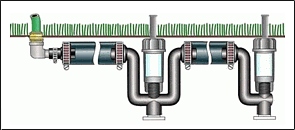A Do-It-Yourself Sprinkler System by LawnBelt USA
by Leon A. Frechette
At the time I wrote this article I was contemplating whether or not I wanted to install a complete sprinkler system. While my goal is to keep my grass green—it's a real hassle dragging the hose around to achieve that goal. The solution, of course, was to install a sprinkler system, and that's what I did—but I didn't put in a traditional underground system. As I was contemplating the problem, a manufacturer contacted me with a system to try.
If you're considering installing a water line to a garden or a sprinkler system in an existing lawn, then you might want to try a Do-It-Yourself Sprinkler System from LawnBelt USA. I believe it's an easy and economical solution to "The Watering Blues." Even though it's simple, be sure to check with your local building department to see if you need a permit or a backflow prevention assembly.
 LawnBelt is a unique patented product made especially for the do-it-yourself market. Essentially, it's a sprinkler system in a box. This system is so simple because you don't need a lot of tools to put it in, nor do you tear up the lawn. The clever diamond-shaped design allows for installation just below the soil line. Simply pry the ground open about 2 inches with a flat spade and spread it out. We're only talking 3 inches to 4 inches deep (see drawing to the right of a condensed system). LawnBelt is a unique patented product made especially for the do-it-yourself market. Essentially, it's a sprinkler system in a box. This system is so simple because you don't need a lot of tools to put it in, nor do you tear up the lawn. The clever diamond-shaped design allows for installation just below the soil line. Simply pry the ground open about 2 inches with a flat spade and spread it out. We're only talking 3 inches to 4 inches deep (see drawing to the right of a condensed system).
The LawnBelt kit includes 50 feet of flexible polyethylene plastic hose, three adjustable pop-up sprinkler heads, all the fittings to put the system together, and a short hose to attach to the house spigot or timer (if you choose to use one). The only tools you need are a flat spade, a utility knife, and a screwdriver.
Having installed the system, I want to share a few pointers to help make your project go in much easier.
First, be sure to follow the instructions that come with each kit.
Second, the system comes with three sprinkler heads, but it is possible to add additional heads. This depends on the water pressure and gallons per minute (gpm) flow your water line offers.
Third, because of frost, I installed a 1" nipple to raise the sprinkler head so I could bury the water line a little deeper than the manufacturer recommends. I found the sprinkler heads a little short when attached to the sprinkler adapter, and I wanted to go below the root line of the grass to allow for frost heave.
Fourth, before working with the water line, unroll it and let it relax in the sun. It's a lot easier to install the water line components in warm weather than in cold.
Finally, put the entire system together and test it before installing it in the ground. It will save a lot of time and headaches and is better than discovering—too late—that something went wrong or you didn't get the coverage you expected.
The system is backed by a five-year limited warranty and accessory items are available for convenience in bringing water to gardens, pools, dog pens, barns, utility sheds, etc.
For more information on the LawnBelt sprinkler system, please visit www.lawnbeltusa.com.
Copyright © 1997 & 2008 LAF/C.R.S., Inc. All rights reserved. The previous article,
in whole or in part, appeared in the October 1997 issue of
Tech Directions.
Looking for home improvement Q&As? Click here!
[ Back to Top ]
|


